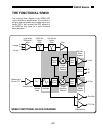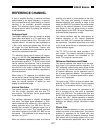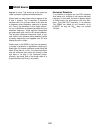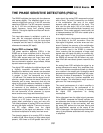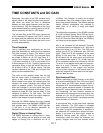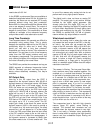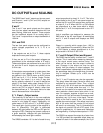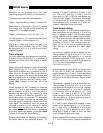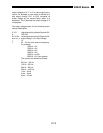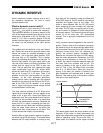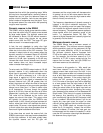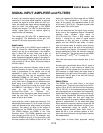
3-12
SR850 Basics
need to be at 0.001 Hz!
In the SR850, synchronous filters are available at
detection frequencies below 200 Hz. At higher fre-
quencies, the filters are not required (2F is easily
removed without using long time constants).
Below 200 Hz, the synchronous filter follows either
one or two stages of normal filters. The output of
the synchronous filter is followed by two more
stages of normal filters. This combination of filters
notches all multiples of the reference frequency
and provides overall noise attenuation as well.
Long Time Constants
Time constants above 100 seconds are difficult to
accomplish using analog filters. This is simply
because the capacitor required for the RC filter is
prohibitively large (in value and in size!). Why
would you use such a long time constant?
Sometimes you have no choice. If the reference is
well below 1 Hz and there is a lot of low frequency
noise, then the PSD output contains many very
low frequency components. The synchronous filter
only notches multiples of the reference frequency,
the noise is filtered by the normal filters.
The SR850 can provide time constants as long as
30000 seconds at reference frequencies below
200 Hz. Obviously you don't use long time con-
stants unless absolutely necessary, but they're
available.
DC Output Gain
How big is the DC output from the PSD? It
depends on the dynamic reserve. With 60 dB of
dynamic reserve, a noise signal can be 1000 times
(60 dB) greater than a full scale signal. At the
PSD, the noise can not exceed the PSD's input
range. In an analog lock-in, the PSD input range
might be 5V. With 60 dB of dynamic reserve, the
signal will be only 5 mV at the PSD input. The
PSD typically has no gain so the DC output from
the PSD will only be a few millivolts! Even if the
PSD had no DC output errors, amplifying this milli-
volt signal up to 10 V is error prone. The DC
output gain needs to be about the same as the
dynamic reserve (1000 in this case) to provide a
10 V output for a full scale input signal. An offset
as small as 1 mV will appear as 1 V at the output!
In fact, the PSD output offset plus the input offset
of the DC amplifier needs to be on the order of
10 µV in order to not affect the measurement. If
the dynamic reserve is increased to 80dB, then
this offset needs to be 10 times smaller still. This
is one of the reasons why analog lock-ins do not
perform well at very high dynamic reserve.
The digital lock-in does not have an analog DC
amplifier. The output gain is yet another function
handled by the digital signal processor. We
already know that the digital PSD has no DC
output offset. Likewise, the digital DC amplifier has
no input offset. Amplification is simply taking input
numbers and multiplying by the gain. This allows
the SR850 to operate with 100 dB of dynamic
reserve without any output offset or zero drift.
What about resolution?
Just like the analog lock-in where the noise can
not exceed the input range of the PSD, in the digi-
tal lock-in, the noise can not exceed the input
range of the A/D converter. With a 16 bit A/D con-
verter, a dynamic reserve of 60 dB means that
while the noise has a range of the full 16 bits, the
full scale signal only uses 6 bits. With a dynamic
reserve of 80 dB, the full scale signal uses only
2.5 bits. And with 100 dB dynamic reserve, the
signal is below a single bit! Clearly multiplying
these numbers by a large gain is not going to
result in a sensible output. Where does the output
resolution come from?
The answer is filtering. The low pass filters effec-
tively combine many data samples together. For
example, at a 1 second time constant, the output
is the result of averaging data over the previous 4
or 5 seconds. At a sample rate of 256 kHz, this
means each output point is the exponential aver-
age of over a million data points. (A new output
point is computed every 4 µs and is a moving
exponential average). What happens when you
average a million points? To first order, the result-
ing average has more resolution than the incoming
data points by a factor of million . This represents
a gain of 20 bits in resolution over the raw data. A
1 bit input data stream is converted to 20 bits of
output resolution from 1 out of a million all the way
up to a million out of a million or 1.
The compromise here is that with high dynamic
reserve (large DC gains), some filtering is
required. The shortest time constants are not
available when the dynamic reserve is very high.
This is not really a limitation since presumably
there is noise which is requiring the high dynamic
reserve and thus substantial output filtering will
also be required.




